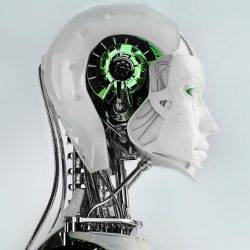 Originally published November 26, 2019. As modern-day employees and consumers, technology has become so commonplace that it now impacts almost every aspect of our lives – both personally and professionally. We can now communicate with whomever we want, wherever we want with the simple click of a button or tap of a smartphone. We can also automate mundane workplace tasks, and even customise software to our hearts’ content. This is not the future of work but the present.
Originally published November 26, 2019. As modern-day employees and consumers, technology has become so commonplace that it now impacts almost every aspect of our lives – both personally and professionally. We can now communicate with whomever we want, wherever we want with the simple click of a button or tap of a smartphone. We can also automate mundane workplace tasks, and even customise software to our hearts’ content. This is not the future of work but the present.
Despite technology’s evident power to make a positive difference, what is also clear is that it isn’t the be-all and end-all when it comes to workplace success. Human input remains instrumental to the performance and growth of any business: staff provide the innovative impetus and independent thought that drives the organisation forward, while technology acts as a medium through which this innovation can be facilitated. This is why achieving a harmonious blend of human and technological involvement is key to the future of work.
Belief in the blend, but more to be done
According to a poll we carried out at the CIPD Festival of Work earlier this year, the large majority (85 percent) of U.K. business leaders, HR professionals and learning and development experts believe that the success of the future workplace depends on an effective, strategic combination of humans and technology.
It’s clear that people believe in this blend, but questions remain about whether or not we’ve achieved it yet. The same poll also found that only a quarter of organisations (25 percent) are currently using HR technologies that harness artificial intelligence (AI) or machine learning capabilities to drive positive transformation for employees.
The flip side to this – and the good news – is that almost half (45 percent) are planning to implement AI-enabled HR technologies to improve the future employee experience. Many companies might not quite be there yet, but reaching this harmony is very much on their agendas.
Attraction and retention
Many of the potential benefits of AI and machine learning are abundantly clear, such as the ability to drive greater productivity by streamlining manual processes and delivering insightful workforce data in real time. However, these technologies can also have a positive impact on attracting and retaining talent.
[perfectpullquote align=”right” bordertop=”false” cite=”” link=”” color=”” class=”” size=””]92 percent of UK employees believe that AI could improve the way they do their job[/perfectpullquote]
Another recent survey carried out by The Workforce Institute at Kronos found that 92 percent of UK employees believe that AI could improve the way they do their job, with 38 percent believing that it could enable them to spend less time on mundane, basic tasks and more time on more pressing responsibilities. When considered this way, it becomes evident that access to the latest tech has a strong bearing on employee fulfilment.
Moreover, it’s important to view workplace innovations in the context of the modern worker and their expectations when it comes to technology. In our personal lives, we expect the technology we use to operate intuitively, smoothly and efficiently, whether it’s the apps on our smartphones, or the television shows we want to access and watch on Netflix. Given the increasingly tech-native characteristics of the global workforce, workplace technology is expected to perform just as effectively, with 50 percent of survey respondents saying they wished the tools they use at work reflected those they use at home in terms of ease of use and functionality.
From this, the requirement for organisations becomes clear: give your employees the technology that works well and helps them reach their goals, and they will become happier, more effective and more engaged workers.
People innovate, technology facilitates
Building this harmony between humans and technology is all about balance. It’s critical to introduce technology into the workplace in order to increase productivity, but it must be done in a way that considers the needs of employees. Technology is not there to take jobs away; it is there to complement and enhance the role of human staff, thereby enabling them to become more rounded workers.
If businesses continue to emphasise the importance of people as part of the overall success of the organisation, they’ll be in a great position to develop a harmonious workplace of the future.
Peter Harte is Vice President of Enterprise Sales, Europe, the Middle East, and Africa (EMEA) at Kronos




















May 12, 2020
From the archive: The future of work will be defined by a harmony of people and technology
by Peter Harte • Comment, Technology
Despite technology’s evident power to make a positive difference, what is also clear is that it isn’t the be-all and end-all when it comes to workplace success. Human input remains instrumental to the performance and growth of any business: staff provide the innovative impetus and independent thought that drives the organisation forward, while technology acts as a medium through which this innovation can be facilitated. This is why achieving a harmonious blend of human and technological involvement is key to the future of work.
Belief in the blend, but more to be done
According to a poll we carried out at the CIPD Festival of Work earlier this year, the large majority (85 percent) of U.K. business leaders, HR professionals and learning and development experts believe that the success of the future workplace depends on an effective, strategic combination of humans and technology.
It’s clear that people believe in this blend, but questions remain about whether or not we’ve achieved it yet. The same poll also found that only a quarter of organisations (25 percent) are currently using HR technologies that harness artificial intelligence (AI) or machine learning capabilities to drive positive transformation for employees.
The flip side to this – and the good news – is that almost half (45 percent) are planning to implement AI-enabled HR technologies to improve the future employee experience. Many companies might not quite be there yet, but reaching this harmony is very much on their agendas.
Attraction and retention
Many of the potential benefits of AI and machine learning are abundantly clear, such as the ability to drive greater productivity by streamlining manual processes and delivering insightful workforce data in real time. However, these technologies can also have a positive impact on attracting and retaining talent.
[perfectpullquote align=”right” bordertop=”false” cite=”” link=”” color=”” class=”” size=””]92 percent of UK employees believe that AI could improve the way they do their job[/perfectpullquote]
Another recent survey carried out by The Workforce Institute at Kronos found that 92 percent of UK employees believe that AI could improve the way they do their job, with 38 percent believing that it could enable them to spend less time on mundane, basic tasks and more time on more pressing responsibilities. When considered this way, it becomes evident that access to the latest tech has a strong bearing on employee fulfilment.
Moreover, it’s important to view workplace innovations in the context of the modern worker and their expectations when it comes to technology. In our personal lives, we expect the technology we use to operate intuitively, smoothly and efficiently, whether it’s the apps on our smartphones, or the television shows we want to access and watch on Netflix. Given the increasingly tech-native characteristics of the global workforce, workplace technology is expected to perform just as effectively, with 50 percent of survey respondents saying they wished the tools they use at work reflected those they use at home in terms of ease of use and functionality.
From this, the requirement for organisations becomes clear: give your employees the technology that works well and helps them reach their goals, and they will become happier, more effective and more engaged workers.
People innovate, technology facilitates
Building this harmony between humans and technology is all about balance. It’s critical to introduce technology into the workplace in order to increase productivity, but it must be done in a way that considers the needs of employees. Technology is not there to take jobs away; it is there to complement and enhance the role of human staff, thereby enabling them to become more rounded workers.
If businesses continue to emphasise the importance of people as part of the overall success of the organisation, they’ll be in a great position to develop a harmonious workplace of the future.
Peter Harte is Vice President of Enterprise Sales, Europe, the Middle East, and Africa (EMEA) at Kronos